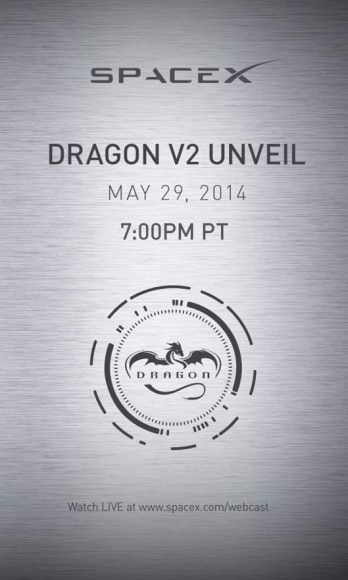Host: Fraser Cain (@fcain)
Guests: Morgan Rehnberg (cosmicchatter.org / @cosmic_chatter), Brian Koberlien (@briankoberlein)
Continue reading “Weekly Space Hangout – May 30, 2014: Gamma Ray Burst? Maybe Not?”
Elon Musk Premiers SpaceX Manned Dragon V2 Astronaut Transporter – 1st Photos

Meet Dragon V2 – SpaceX CEO Elon pulls the curtain off manned Dragon V2 on May 29, 2014 for worldwide unveiling of SpaceX’s new astronaut transporter for NASA. Credit: SpaceX
Story updated[/caption]
SpaceX CEO and billionaire founder Elon Musk gushed with excitement as he counted down the seconds and literally pulled the curtain away to unveil his company’s new manned Dragon V2 astronaut transporter for all the world to see during a live streaming webcast shortly after 10 p.m. EST (7 p.m. PST, 0200 GMT) this evening, Thursday, May 29, from SpaceX HQ.
The first photos from the event are collected herein. And I’ll be adding more and updating this story as they flow in.
Musk’s Dragon V2 unveiling was brimming with excitement like a blockbuster Hollywood Science Fiction movie premiere – with lights, cameras and action.
But this was the real deal and hopefully gets America moving again back to thrilling, real space adventures in orbit and beyond – reaching for the stars.
“The Dragon V2 is a 21st century spacecraft,” Musk announced to a wildly cheering crowd. “As it should be.”
“We wanted to take a big step in spacecraft technology. It is a big leap forward in technology and takes things to the next level.”
“An important characteristic of that is its ability to land anywhere on land, propulsively. It can land anywhere on Earth with the accuracy of a helicopter.”
“I think that’s what a spaceship should be able to do.”
“It will be capable of carrying seven astronauts. And it will be fully reusable.”
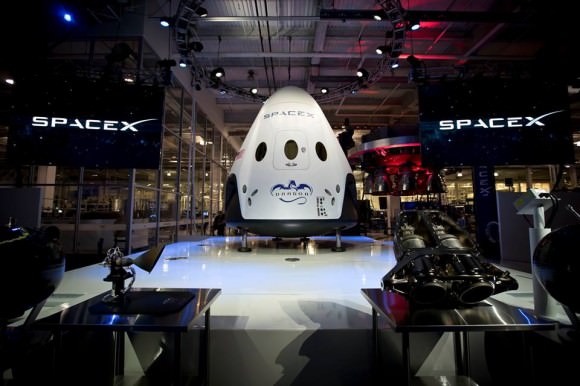
The sleek gleaming spaceship looks decidedly different from the current cargo Dragon V1.
Read my “Dragon V2” preview articles leading up to the May 29 event – here and here.
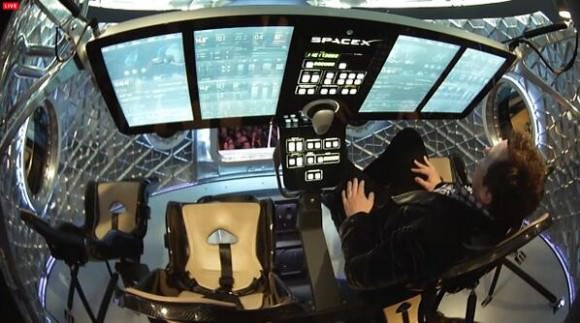
This new manrated Dragon is aimed at restoring US human launch access to space from American soil by carrying crews of up to seven US astronauts to low Earth orbit and eventually perhaps Mars – starting as soon as 2017.
Musk unveiled the gumdrop-shaped Dragon V2, or Version 2, to an overflow crowd of employees and media at SpaceX headquarters and design and manufacturing facility in Hawthorne, CA.
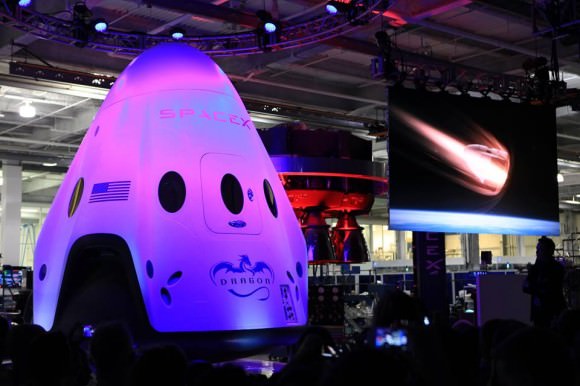
But Musk and SpaceX are not alone in striving to get Americans back to space.
Two other US aerospace firms – Boeing and Sierra Nevada – are competing with SpaceX to build the next generation spaceship to ferry astronauts to and from the ISS by 2017 using seed money from NASA’s Commercial Crew Program in a public/private partnership.
Altogether they have received more than $1 Billion in NASA funding.
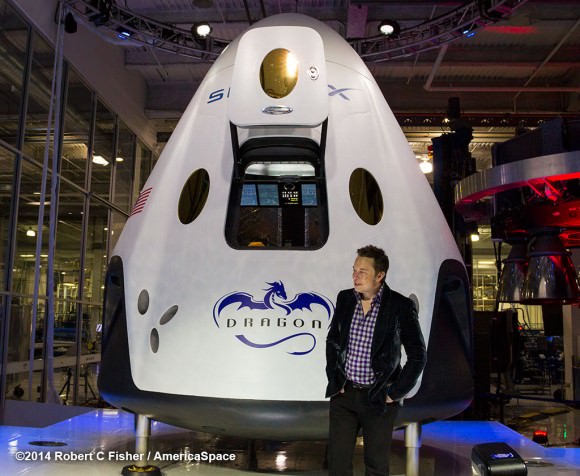
The Boeing CST-100 and Sierra Nevada Dream Chaser ‘space taxis’ are also vying for funding in the next round of contracts to be awarded by NASA around late summer 2014.
The ‘Dragon V2’ is an upgraded, man-rated version of the unmanned Dragon cargo spaceship that just completed its third operational resupply mission to the ISS with a successful splashdown in the Pacific Ocean on May 18.
Stay tuned here for Ken’s continuing SpaceX, Boeing, Sierra Nevada, Orbital Sciences, commercial space, Orion, Mars rover, MAVEN, MOM and more planetary and human spaceflight news.
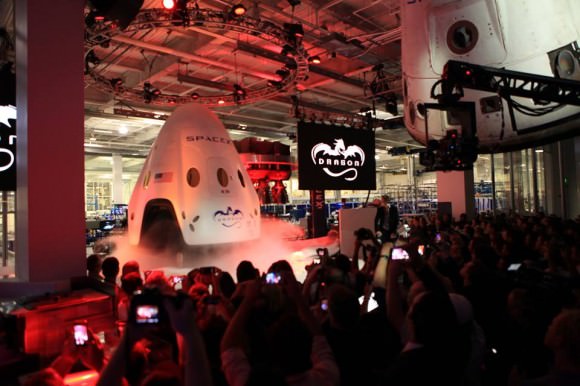
Watch Live Here – SpaceX Founder Elon Musk Unveils Manned “Dragon V2” Spaceship on May 29

SpaceX is hosting a worldwide live premiere event tonight, May 29, unmasking the veil from the company’s commercial “Dragon V2” manned spaceship, the next step in US human spaceflight at 7 p.m. PST (10 p.m. EST, 0200 GMT).
And none other than billionaire entrepreneur Elon Musk, SpaceX CEO and founder, will be the master of ceremonies for the live show direct from SpaceX’s state-of-the-art design and manufacturing facility and Headquarters in Hawthorne, CA!
You can watch LIVE here – via the embedded player above.
Alternatively you can watch courtesy of a streaming webcast courtesy of SpaceX at: www.spacex.com/webcast
Read my “Dragon V2” or “Dragon Version 2” preview story – here.
Musk’s (and NASA’s) goal is to restore America’s capability to launch US astronauts to low Earth orbit and the International Space Station (ISS) by 2017 and to put an end total US dependency on Russia’s Soyuz for astronaut rides to orbit and back.
“SpaceX’s new Dragon V2 spacecraft is a next generation spacecraft designed to carry astronauts into space,” says SpaceX.
“Cover drops on May 29. Actual flight design hardware of crew Dragon, not a mockup,” Musk tweeted recently to build anticipation.

Dragon is among a trio of US private sector manned spaceships being developed with seed money from NASA’s Commercial Crew Program in a public/private partnership to develop a next-generation crew transportation vehicle to ferry astronauts to and from the ISS by 2017 – a capability totally lost following the space shuttle’s forced retirement in 2011.
The Boeing CST-100 and Sierra Nevada Dream Chaser ‘space taxis’ are also vying for funding in the next round of contracts to be awarded by NASA around late summer 2014.
The gumdrop-shaped ‘Dragon V2’ is an upgraded, man rated version of the unmanned Dragon spaceship that will carry a mix of cargo and up to a seven crewmembers to the International Space Station (ISS).
The cargo Dragon just successfully completed its third operational resupply mission to the ISS with a successful splashdown in the Pacific Ocean on May 18.
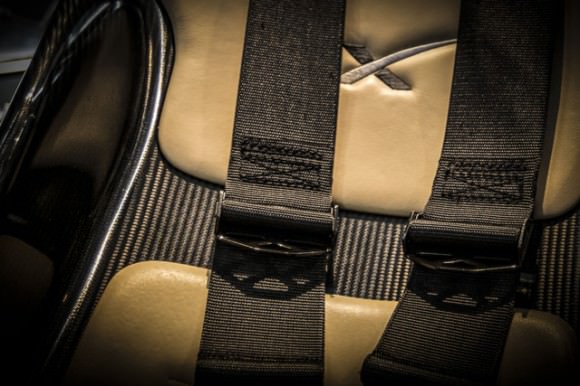
Stay tuned here for Ken’s continuing SpaceX, Boeing, Sierra Nevada, Orbital Sciences, commercial space, Orion, Mars rover, MAVEN, MOM and more planetary and human spaceflight news.

SpaceX CEO Elon Musk to Unveil Manned Dragon ‘Space Taxi’ on May 29

SpaceX Dragon cargo freighter berthed to the International Space Station during recently concluded SpaceX-3 mission in May 2014. An upgraded, manrated version will carry US astronauts to space in the next two to three years. Credit: NASA
Story updated[/caption]
SpaceX CEO, founder and chief designer Elon Musk is set to unveil the manned version of his firms commercial Dragon spaceship later this week, setting in motion an effort that he hopes will soon restore America’s capability to launch US astronauts to low Earth orbit and the International Space Station (ISS) by 2017.
Musk will personally introduce SpaceX’s ‘Space Taxi’ dubbed ‘Dragon V2’ at what amounts to sort of a world premiere event on May 29 at the company’s headquarters in Hawthorne, CA, according to an official announcement this evening (May 27) from SpaceX.
“SpaceX’s new Dragon V2 spacecraft is a next generation spacecraft designed to carry astronauts into space,” according to the SpaceX statement.
The manned Dragon will launch atop the powerful SpaceX Falcon 9 v1.1 rocket from a SpaceX pad on the Florida Space Coast.
Dragon was initially developed as a commercial unmanned resupply freighter to deliver 20,000 kg (44,000 pounds) of supplies and science experiments to the ISS under a $1.6 Billion Commercial Resupply Services (CRS) contract with NASA during a dozen Dragon cargo spacecraft flights through 2016.
Musk is making good on a recent comment he posted to twitter on April 29, with respect to the continuing fallout from the deadly crisis in Ukraine which has resulted in some US economic sanctions imposed against Russia, that now potentially threaten US access to the ISS in a boomerang action from the Russian government:
“Sounds like this might be a good time to unveil the new Dragon Mk 2 spaceship that @SpaceX has been working on with @NASA. No trampoline needed,” Musk tweeted.
“Cover drops on May 29. Actual flight design hardware of crew Dragon, not a mockup,” Musk added.
The ‘Dragon V2’ is an upgraded, man rated version of the unmanned spaceship that can carry a mix of cargo and up to a seven crewmembers to the ISS.
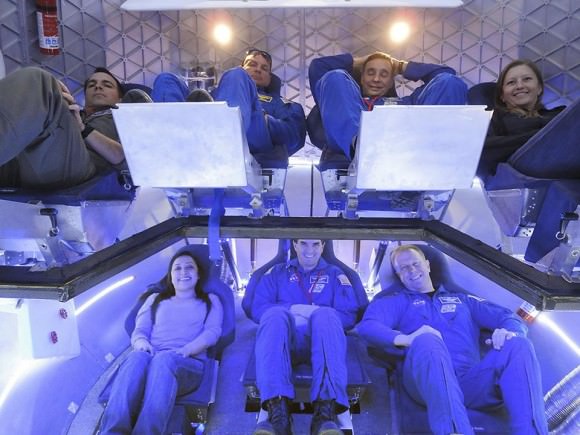
Dragon is among a trio of US private sector manned spaceships being developed with seed money from NASA’s Commercial Crew Program in a public/private partnership to develop a next-generation crew transportation vehicle to ferry astronauts to and from the ISS by 2017 – a capability totally lost following the space shuttle’s forced retirement in 2011.
Since that day, US astronauts have been totally dependent on the Russian Soyuz capsules for ferry rides to orbit and back.
The Boeing CST-100 and Sierra Nevada Dream Chaser ‘space taxis’ are also vying for funding in the next round of contracts to be awarded by NASA around late summer 2014.
All three company’s have been making excellent progress in meeting their NASA mandated milestones in the current contract period known as Commercial Crew Integrated Capability initiative (CCiCAP) under the auspices of NASA’s Commercial Crew Program.
However, US progress getting the space taxis actually built and flying has been repeatedly stifled by the US Congress who have severely cut NASA’s budget request for the Commercial Crew Program by about half each year. Thus forcing NASA to delay the first manned orbital test flights by at least 18 months from 2015 to 2017.
The situation with regard to US dependency on Russian rocketry to reach the ISS has always been awkward.
But it finally took on new found importance and urgency from politicos in Washington, DC, since the ongoing crisis in Ukraine this year exposed US vulnerability in a wide range of space endeavors affecting not just astronaut rides to the ISS but also the launch of the most critical US national security surveillance satellites essential to US defense.
US space vulnerability became obvious to everyone when Russia’s deputy prime minister, Dmitry Rogozin. who is in charge of space and defense industries, said that US sanctions could “boomerang” against the US space program and that perhaps NASA should “deliver their astronauts to the International Space Station using a trampoline.”

Rogozin also threatened to cut off exports of the Russian made RD-180 rocket engines which power the first stage of the United Launch Alliance (ULA) Atlas V rocket used to launch numerous US National Security spy satellites.
“Moscow is banning Washington from using Russian-made rocket engines, which the US has used to deliver its military satellites into orbit,” Rogozin said at a media briefing held on May 13.
NASA is also a hefty user of the Atlas V for many of the agency’s science and communication satellites like the Curiosity Mars rover, MAVEN Mars orbiter, MMS, Juno Jupiter orbiter and TDRS.
Musk and SpaceX have also filed lawsuits against the US Air Force to legally block the importation of the RD-180 engines by ULA for the Atlas V as a violation of the US economic sanctions.
So overall, US space policy is in a murky and uncertain situation and Musk clearly aims for SpaceX to be a central and significant player in a wide range of US space activities, both manned and unmanned.
Read my earlier articles about the Atlas V controversy, Rogozin’s statements, Musk’s suit and more about the effects of economic sanctions imposed by the US and Western nations in response to Russia’s actions in Ukraine and the annexation of Crimea; here, here, here, here and here.

The 3rd operational Dragon cargo resupply mission completed the 30 day SpaceX-3 flight to the ISS with a successful Pacific Ocean splashdown on May 18.
SpaceX will webcast the Dragon unveiling event LIVE on May 29 at 7 p.m. PST for anyone wishing to watch at: www.spacex.com/webcast
Stay tuned here for Ken’s continuing SpaceX, Boeing, Sierra Nevada, Orbital Sciences, commercial space, Orion, Mars rover, MAVEN, MOM and more planetary and human spaceflight news.

Return of the SpaceX-3 Dragon to Earth Caps Super Science Mission for NASA
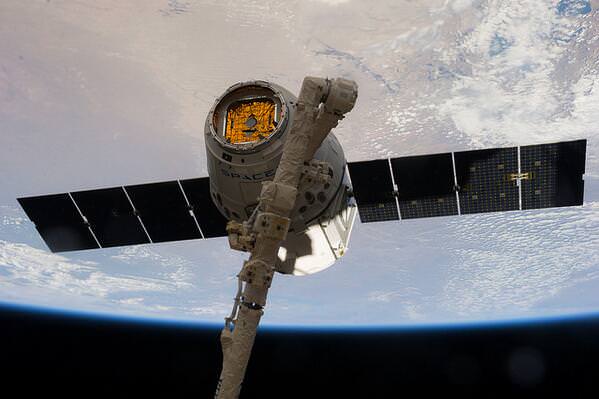
SpaceX-3 Dragon commercial cargo freighter was detached from the ISS at 8 AM EDT on May 18, 2014 and released by station crew at 9:26 AM for splashdown in the Pacific Ocean with science samples and cargo. Credit: NASA
Story updated[/caption]
The 30 day flight of the SpaceX-3 Dragon commercial cargo freighter loaded with a huge cache of precious NASA science experiments including a freezer packed with research samples ended today with a spectacular departure from the orbiting lab complex soaring some 266 miles (428 km) above Earth.
Update 3:05 PM EDT May 18: SpaceX confirms successful splashdown at 3:05 p.m. EDT today.
“Splashdown is confirmed!! Welcome home, Dragon!”
Robotics officers at Mission Control at NASA’s Johnson Space Center detached Dragon from the Earth-facing port of the Harmony module at 8 a.m. EDT (1300 GMT) this morning, Sunday, May 18, 2014 using the stations Canadian-built robotic arm.
Engineers had earlier unbolted all 16 hooks and latches firmly connecting the vehicle to the station in preparation.
NASA astronaut Steve Swanson then commanded the gum dropped shaped Dragon capsule’s release from Canadarm2 as planned at 9:26 a.m. EDT (1326 GMT) while the pair were flying majestically over southern Australia.
The undocking operation was shown live on NASA TV.
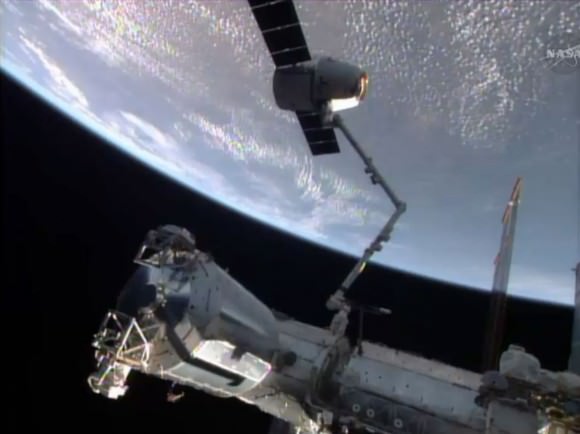
Swanson was assisted by Russian cosmonaut Alexander Skvortsov as the US- Russian team were working together inside the domed Cupola module.
Following the cargo ships release by the 57 foot long arms grappling snares, Swanson carefully maneuvered the arm back and away from Dragon as it moved ever so slowly in free drift mode.
It was already four feet distant within three minutes of release.
Three departure burns by the Dragon’s Draco maneuvering thrusters followed quickly in succession and occurred precisely on time at 9:29, 9:30 and 9:38 a.m. EST.
Dragon exited the 200 meter wide keep out zone – an imaginary bubble around the station with highly restricted access – at the conclusion of the 3rd departure burn.
“The Dragon mission went very well. It was very nice to have a vehicle take science equipment to the station, and maybe some day even humans,” Swanson radioed after the safe and successful departure was completed.
“Thanks to everyone who worked on the Dragon mission.”
The private SpaceX Dragon spent a total of 28 days attached to the ISS.
The six person international crew from Russia, the US and Japan on Expeditions 39 and 40 unloaded some 2.5 tons of supplies aboard and then repacked it for the voyage home.
The SpaceX resupply capsule is carrying back about 3500 pounds of spacewalk equipment, vehicle hardware, science samples from human research, biology and biotechnology studies, physical science investigations and education activities, as well as no longer needed trash.
“The space station is our springboard to deep space and the science samples returned to Earth are critical to improving our knowledge of how space affects humans who live and work there for long durations,” said William Gerstenmaier, associate administrator for human exploration and operations.
“Now that Dragon has returned, scientists can complete their analyses, so we can see how results may impact future human space exploration or provide direct benefits to people on Earth.”
Among the research investigations conducted that returned samples in the cargo hold were an examination of the decreased effectives of antibiotics in space, better growth of plants in space, T-Cell activation in aging and causes of human immune system depression in the microgravity environment.
The 10 minute long deorbit burn took place as scheduled at 2:10 p.m. EDT (1810 GMT) today.
Dragon returned to Earth for a triple parachute assisted splash down today at around 3:02 p.m. EDT (19:02 GMT) in the Pacific Ocean – some 300 miles west of Baja California.
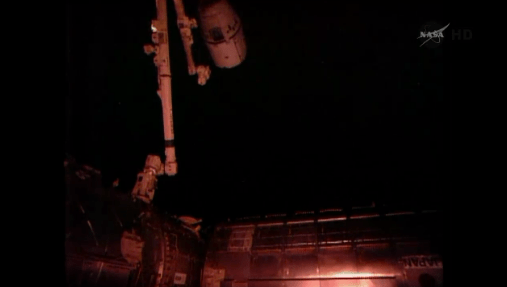
It will be retrieved by recovery boats commissioned by SpaceX. The science cargo will be extracted and then delivered to NASA’s Johnson Space Center within 48 hours.
Dragon thundered to orbit atop SpaceX’s powerful new Falcon 9 v1.1 rocket on April 18, from Cape Canaveral, Fla.
This unmanned Dragon delivered about 4600 pounds of cargo to the ISS including over 150 science experiments, a pair of hi tech legs for Robonaut 2, a high definition Earth observing imaging camera suite (HDEV), the laser optical communications experiment (OPALS), the VEGGIE lettuce growing experiment as well as essential gear, spare parts, crew provisions, food, clothing and supplies to the six person crews living and working aboard in low Earth orbit.
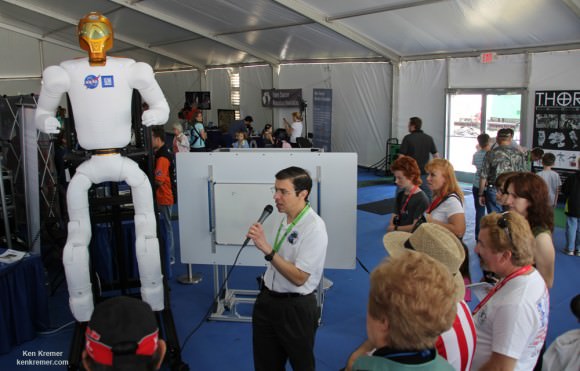
It reached the ISS on April 20 for berthing.
Dragon is the only unmanned resupply vessel supply that also returns cargo back to Earth.
The SpaceX-3 mission marks the company’s third resupply mission to the ISS under the $1.6 Billion Commercial Resupply Services (CRS) contract with NASA to deliver 20,000 kg (44,000 pounds) of cargo to the ISS during a dozen Dragon cargo spacecraft flights through 2016.
The SpaceX Dragon is among a trio of American vehicles, including the Boeing CST-100 and Sierra Nevada Dream Chaser vying to restore America’s capability to fly humans to Earth orbit and the space station by late 2017, using seed money from NASA’s Commercial Crew Program (CCP) in a public/private partnership. The next round of contracts will be awarded by NASA about late summer 2014.
Another significant milestone was the apparently successful attempt by SpaceX to accomplish a controlled soft landing of the Falcon 9 boosters first stage in the Atlantic Ocean for eventual recovery and reuse. It was a first step in a guided 1st stage soft landing back at the Cape.
The next unmanned US cargo mission to the ISS is set for early morning on June 10 with the launch of the Orbital Sciences Cygnus freighter atop an Antares booster from a launch pad at NASA’s Wallops Flight Facility on the eastern shore of Virginia.
Stay tuned here for Ken’s continuing SpaceX, Orbital Sciences, Boeing, commercial space, Orion, Chang’e-3, LADEE, Curiosity, Mars rover, MAVEN, MOM and more planetary and human spaceflight news.
………
Ken’s upcoming presentation: Mercy College, NY, May 19: “Curiosity and the Search for Life on Mars” and “NASA’s Future Crewed Spaceships.”
Weekly Space Hangout – May 9, 2014: Virtual Universes & Plants for Mars
Host: Fraser Cain (@fcain)
Guests: Scott Lewis, Morgan Rehnberg, Casey Dreier
Continue reading “Weekly Space Hangout – May 9, 2014: Virtual Universes & Plants for Mars”
Dangling Dextre Digs out Docked Dragon Depot prior to Station Departure
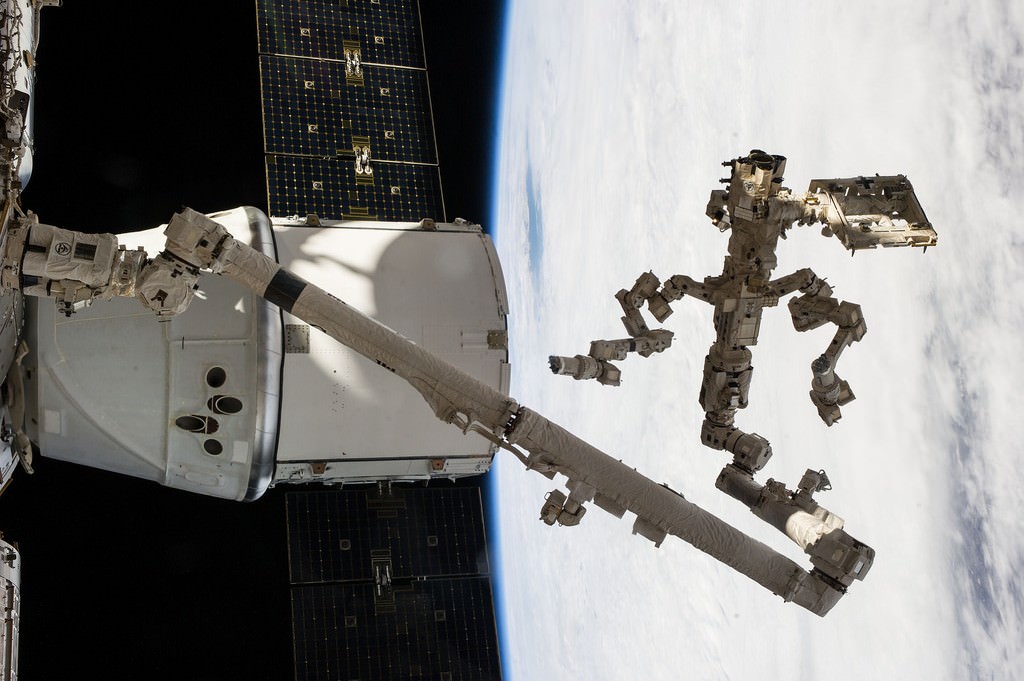
To close out their final week aboard the International Space Station, three of the six Expedition 39 crew members are completing their unloading tasks inside the docked commercial SpaceX Dragon cargo freighter and other duties while teams at Mission Control in Houston conduct delicate robotics work outside with dazzling maneuvers of the Dextre robot to remove the last external experiment from the vessels storage truck.
See a dazzling gallery of photos of Dextre dangling outside the docked Dragon depot – above and below.
On Monday, May 5, the robotics team at NASA Mission Control Center at the Johnson Space Center in Houston carefully guided Canada’s Dextre robotic “handyman” attached to the end of the 57-foot long Canadarm2 to basically dig out the final payload item housed in the unpressurized trunk section at the rear of the SpaceX Dragon cargo vessel docked to the ISS.
Dextre stands for “Special Purpose Dexterous Manipulator” and was contributed to the station by the Canadian Space Agency. It measures 12 feet tall and is outfitted with a pair of arms and an array of finely detailed tools to carry out intricate and complex tasks that would otherwise require spacewalking astronauts.
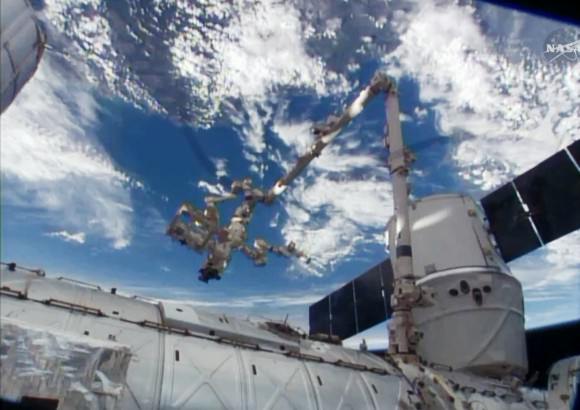
The massive orbiting outpost was soaring some 225 miles above the home planet as Dextre’s work was in progress to remove the Optical PAyload for Lasercomm Science, or OPALS, from the Dragon’s truck.
The next step is to install OPALS on the Express Logistics Carrier-1 (ELC-1) depot at the end of the station’s port truss on Wednesday.
Monday’s attempt was the second try at grappling OPALS. The initial attempt last Thursday “was unsuccessful due to a problem gripping the payload’s grapple fixture with the Special Purpose Dextrous Manipulator, or Dextre,” NASA reported.
A software patch solved the problem.
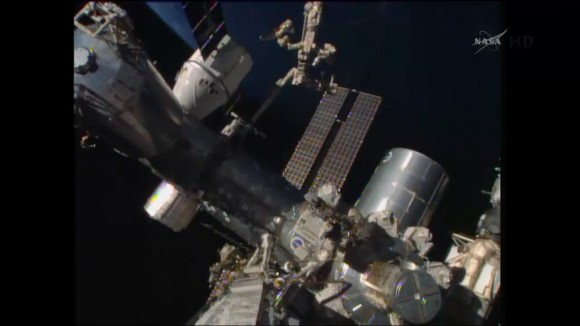
Dragon thundered to orbit atop SpaceX’s powerful new Falcon 9 v1.1 rocket on April 18, from Cape Canaveral, Fla.
This unmanned Dragon delivered about 4600 pounds of cargo to the ISS including over 150 science experiments, a pair of hi tech legs for Robonaut 2, a high definition Earth observing imaging camera suite (HDEV), the laser optical communications experiment (OPALS), the VEGGIE lettuce growing experiment as well as essential gear, spare parts, crew provisions, food, clothing and supplies to the six person crews living and working aboard in low Earth orbit, under NASA’s Commercial Resupply Services (CRS) contract.
OPALS uses laser light instead of radio waves to beam back precisely guided data packages to ground stations. The use of lasers should greatly increase the amount of information transmitted over the same period of time, says NASA.
The science experiments carried aboard Dragon are intended for research to be conducted by the crews of ISS Expeditions 39 and 40.
Robotics teams had already pulled out the other payload item from the truck, namely the HDEV imaging suite. It is already transmitting back breathtaking real time video views of Earth from a quartet of video cameras pointing in different directions mounted on the stations exterior.
The SpaceX CRS-3 mission marks the company’s third resupply mission to the ISS under a $1.6 Billion contract with NASA to deliver 20,000 kg (44,000 pounds) of cargo to the ISS during a dozen Dragon cargo spacecraft flights through 2016.
After spending six months in space, Station Commander Koichi Wakata from Japan as well as NASA astronaut Rick Mastracchio and Russian cosmonaut Mikhail Tyurin will be departing the station in a week aboard their Soyuz TMA-11M spacecraft on May 13 at 6:33 p.m. EDT.
They are scheduled to land some 3.5 hours later in the steppes of Kazakhstan at 9:57 p.m. (7:57 a.m. Kazakh time on May 14). The events will be carried live on NASA TV.
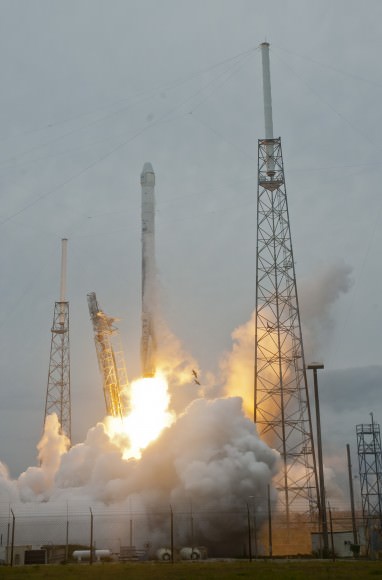
Meanwhile Dragon is also set to depart the station soon on May 18 for a parachute assisted splashdown and recovery by boats in the Pacific Ocean west of Baja California.
Dragon has been docked to the station since arriving on Easter Sunday morning, April 20.
It was grappled using Canadarm 2 and berthed at the Earth facing port of the Harmony module by Commander Wakata and flight engineer Mastracchio while working at the robotics work station inside the seven windowed domed Cupola module.
For the return trip, the Expedition 39 crew is also loading Dragon with precious science samples collected over many months from the crews research activities as well as trash and no longer needed items.
Stay tuned here for Ken’s continuing SpaceX, Orbital Sciences, commercial space, Orion, Chang’e-3, LADEE, Curiosity, Mars rover, MAVEN, MOM and more planetary and human spaceflight news.
Weekly Space Hangout – May 2, 2014: Gas Clouds & Photobombs
Host: Fraser Cain (@fcain)
Guests: Morgan Rehnberg (cosmicchatter.org / @cosmic_chatter), Nancy Atkinson (@Nancy_A)
Continue reading “Weekly Space Hangout – May 2, 2014: Gas Clouds & Photobombs”
Court Injunction Blocks Russian Engine Purchase by ULA for US National Security – Win for SpaceX Yields Uncertainty
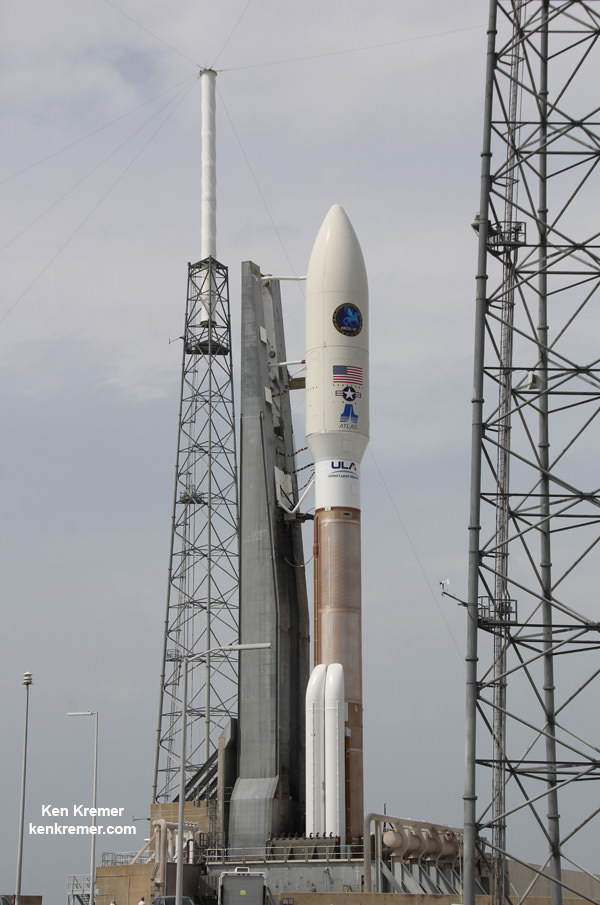
United Launch Alliance Atlas V rocket – powered by Russian made RD-180 engines – and Super Secret NROL-67 intelligence gathering payload poised for launch at Space Launch Complex 41 at Cape Canaveral Air Force Station, FL, in March 2014. Credit: Ken Kremer – kenkremer.com
Story updated[/caption]
A US Federal Court has now issued a preliminary injunction that blocks the purchase and importation of Russian rocket engines by United Launch Alliance (ULA) for its Atlas V rocket used in National Security launches for the US Air Force after a filing by SpaceX. But what are the implications?
The US Federal Court of Federal Claims order was issued late Wednesday, April 30, by US Judge Susan G. Braden of the US Court of Federal Claims. The court order is in response to a protest filed by SpaceX against ULA and the US Air Force relating to the uncontested $11 Billion “block buy” launch contract purchase in December of 36 rocket cores for US National Security launches and is also related to US sanctions imposed after Russia’s recent actions in Ukraine and seizing and annexing the Crimea.
The temporary injunction marks a big win for SpaceX but immediately throws future National Security spy satellite and NASA science launches into uncertainty and potential disarray as I reported previously – here and here.
As I posted here last Friday, April 25, SpaceX CEO Elon Musk declared his firms intent to file suit against ULA and the Air Force on Monday, April 28 to break the launch monopoly.
Judge Braden’s injunction followed barely two days later.
Musk said the recent ‘block buy’ launch contract was unfair in blocking SpaceX from competing for launches of surveillance satellites, would cost taxpayers billions of extra dollars in coming years and should be recompetited.
“The national security launches should be put up for competition and they should not be awarded on a sole source, uncompeted basis,” Musk said at the April 25 briefing at the National Press Club in Washington, DC.
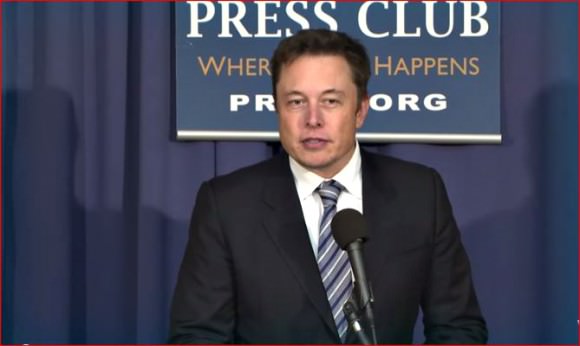
ULA quickly vowed today that they will respond to resolve the injunction and further stated that “This opportunistic action by SpaceX … ignores the potential implications to our National Security.”
Federal Judge Braden’s order specifically states the following; “The preliminary injunction prohibits the United States Air Force and United Launch Alliance, from making any purchases from or payment of money to NPO Energomash or any entity, whether governmental, corporate or individual, that is subject to the control of Deputy Prime Minister Rogozin.”
“IT IS SO ORDERED,” wrote Braden.
The engines at the heart of the Federal preliminary injunction are the RD-180 liquid fueled engines which power ULA’s Atlas V rocket and are manufactured in Russia by NPO Energomash – which is majority state owned by the Russian Federation and subject to the control of Russian Deputy Prime Minister Rogozin, who is specifically named on the US economic sanctions target list.
In response, Rogozin said that sanctions could “boomerang” against the US space program. He said that perhaps NASA should “deliver their astronauts to the International Space Station using a trampoline.”
Thanks to the utter folly of US politicians in shutting down the Space Shuttle program before a replacement crew vehicle was available and repeatedly slashing NASA’s commercial crew budget, American astronauts are now 100% dependent on the Russian Soyuz capsule for rides to the ISS and back for several more years ahead.
NASA has NO immediate alternatives to Russia’s Soyuz – period.
The rocket engine injunction is just the latest fallout impacting a vast swath of US space programs from National Defense to NASA stemming from the dangerously escalating crisis between Ukraine and the Russian Federation in the worst confrontation with the West since the Cold War era.
In response to the worsening Ukraine crisis, Western nations have instituted waves of increasingly harsh economic sanctions against Russia and several key members of the Russian government.
Judge Braden’s injunction stands until she receives clarification otherwise from US government entities that the engine purchase is not covered by the Federal government santions.
The order remains in effect “unless and until the court receives the opinion of the United States Department of the Treasury, and the United States Department of Commerce and United States Department of State, that any such purchases or payments will not directly or indirectly contravene Executive Order 13,661.”
ULA issued a swift statement today – received by Universe Today – from ULA’s general counsel Kevin G. MacCary, in response to Judge Braden’s preliminary injunction.
“ULA is deeply concerned with this ruling and we will work closely with the Department of Justice to resolve the injunction expeditiously. In the meantime, ULA will continue to demonstrate our commitment to our National Security on the launch pad by assuring the safe delivery of the missions we are honored to support.”
“SpaceX’s attempt to disrupt a national security launch contract so long after the award ignores the potential implications to our National Security and our nation’s ability to put Americans on board the International Space Station.”
The Atlas V rocket, powered by the Russian made RD-180 engines, will also be used as the launch vehicle by two of the three companies vying for the next round of commercial crew contracts aimed at launching US astronauts to the ISS. The contracts will be awarded by NASA later this year.
“This opportunistic action by SpaceX appears to be an attempt to circumvent the requirements imposed on those who seek to meet the challenging launch needs of the nation and to avoid having to follow the rules, regulations and standards expected of a company entrusted to support our nation’s most sensitive missions,” said ULA.
ULA is a joint venture between aerospace giants Boeing and Lockheed Martin, formed in 2006. It has conducted 81 consecutive launches with 100% mission success – including many NASA science and mission probes like Orion EFT-1, Curiosity, MAVEN, TDRS and more.
Judge Braden furthermore made clear that her order did not include prior RD-180 engine purchases.
“The scope of this preliminary injunction does not extend to any purchase orders that have been placed or moneys paid to NPO Energomash prior to the date of this
Order [April 30, 2014].”
ULA has a two year contingency supply of the RD-180’s and blueprints to begin production, if needed.
However in the event of a cutoff by Russia or US court injuncions, it would take ULA at least three to five years to start and certify RD-180 engine production somewhere in the US, a ULA spokesperson told me recently at Cape Canaveral.
This possibly leaves a 1 to 3 year gap with no Atlas V 1st stage engine supply.
SpaceX claims they can fill part of the launch gap. But their Falcon rockets are not yet certified for National Security launches.
“So far we are most of the way through the certification process. And so far there have been zero changes to the rocket. Mostly it’s just been a paperwork exercise.”
“In light of international events, this seems like the wrong time to send hundreds of millions of dollars to the Kremlin,” said Musk during the April 25 press briefing at the National Press Club in Washington, DC.

Watch for my continuing articles as the Ukraine crisis escalates and court orders fly – with uncertain and potentially dire consequences for US National Security and NASA.
Stay tuned here for Ken’s continuing SpaceX, Orbital Sciences, commercial space, Orion, Chang’e-3, LADEE, Mars rover, MAVEN, MOM and more planetary and human spaceflight news.
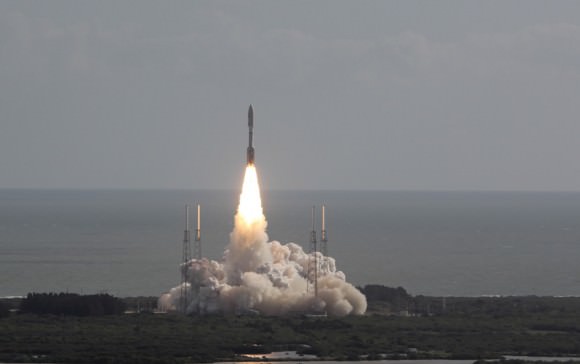
Credit: Ken Kremer – kenkremer.com
SpaceX Releases Raw Video of First Stage Landing Attempt
Video released today by SpaceX confirms the landing legs deployed successfully on the Falcon 9’s first stage booster, paving the way for future vertical soft touchdowns on land. SpaceX’s next-generation Falcon 9 rocket was tested following the launch of the CRS-3 mission for the Dragon spacecraft, which launched from Cape Canaveral Air Force Station on April 18. This was the first test of the landing legs deployment with a re-entry burn and soft landing in the Atlantic Ocean.
The SpaceX CEO had mentioned the success during a post launch briefing and later tweeted further updates that the Falcon 9 first stage actually made a good water landing despite rough seas, with waves swelling at least six feet. He also spoke briefly of the success during a news conference at the National Press Club on April 25, saying video would be released soon.
The video above is actually a cleaned-up (repaired) version of the original. There are a short few frames which show the landing legs deployed just before splashdown, which Musk highlighted in a recent Tweet. Obviously this is not the greatest-quality video ever released, but exciting still the same. SpaceX is actually looking for help in cleaning up the video even further.

